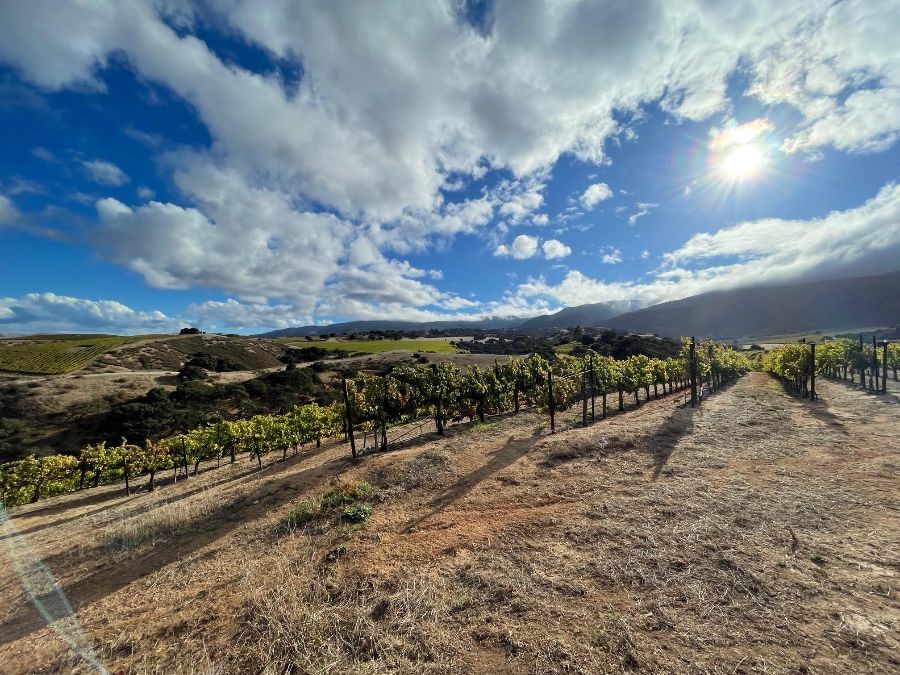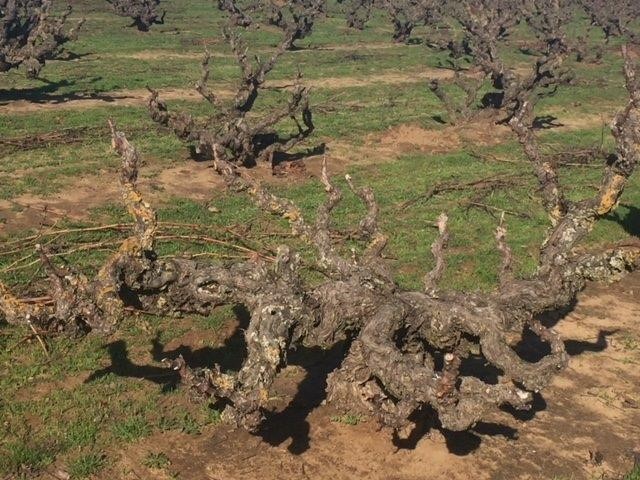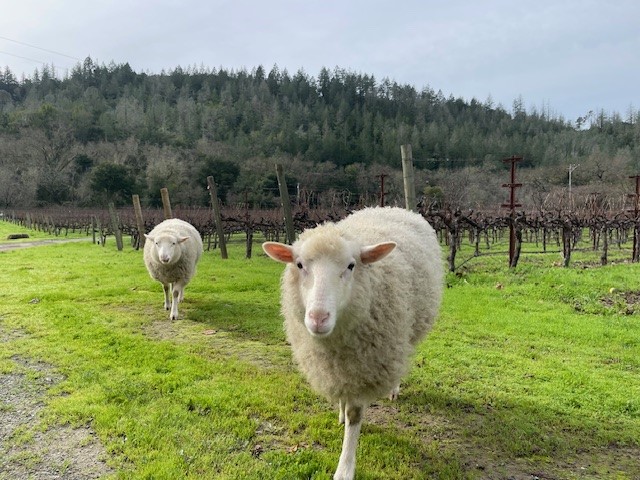Neyers Vineyards Bruce's Journal
Our 2021 Sage Canyon Red
By Bruce Neyers
Saturday 2nd March, 2024
The raw beauty of the Lomo del Rio Cinsault Vineyard in King City typifies the 2021 vintage for us. The growing season was delayed with beautifully cool autumn weather, and the grapes were harvested with an ideal sugar and acid mix. The colors are bright, and the wine is loaded with delicious, exotic flavors.
Growing conditions in 2021 were wonderful, and only a small percentage of our grapes were harvested in August. The bulk of the picking was done in September and October. We began on August 23 with the Carignan from the Evangelho Vineyard, but most of the other fruit was picked between September 7 and September 28. We found some beautiful, old-vine Cinsault this year at the Lomo del Rio Ranch in King City, and we picked 11 tons on October 21. This was two days before we finished the vintage with the Mourvèdre harvest on October 23, at Diamond West Ranch in San Luis Obispo. Never before has our Sage Canyon Red included such a vast swath of California vineyard sources.
All of the fruit was harvested by hand into half-ton bins, then trucked to our Sage Canyon winery in the Napa Valley. The bins were dumped onto the sorting table, where every cluster was individually inspected by four sets of eyes. The whole berries were then pumped to an open-top stainless-steel tank. We retain 100% of the stems with the grapes for this wine, a process we learned from our winemaking friends in the south of France. The stems brighten the color, and add an attractive natural rusticity to the aroma.
We rely on native yeast fermentation, and after it begins, we start a twice-daily pigeage, by walking on the top of the cap for 30 minutes morning and afternoon. This traditional French technique pushes the whole clusters below the surface, where they come in contact with the fermenting juice, darkening the color and softening the tannins. Eventually the skins of the individual berries break, releasing their juice. After 30 days, the tank was drained and pressed, and the new wine was racked to neutral 60-gallon French oak barrels for aging. The wine went through a complete secondary fermentation, and was allowed to settle naturally. We bottled in June 2022, without fining or filtration.
We look for each grape variety in this wine to add an element to the blend. The Carignan is hearty and structured, with bright fruit. The Mourvèdre is sturdy, with long mineral tones. The Cinsault adds a velvety texture, both fresh and complex, while the Grenache adds a soft finish, and a wide range of exotic aromas — floral, fruit, and spice. I love it with almost everything Barbara cooks, but it sure goes well with her homemade chili.
The final blend this year is 30% Carignan, 30% Mourvèdre, 25% Cinsault, and 15% Grenache.
In January 1969, Barbara and I moved to El Paso, Texas where I attended the US Army Guided Missile school for officers at Fort Bliss. We loved that area, with its great weather, the multi-cultural atmosphere from its proximity to Juarez Mexico, the beautiful neighboring areas like White Sands, New Mexico, and of course the food. I never took Chili seriously until I had it in El Paso, and now Barbara makes her own interpretation of it from time to time, according to the availability of beans from Rancho Gordo. No wine seems to work with it better than our Sage Canyon Red.
Black Bean Chili
Ingredients
- ½ pound Rancho Gordo Domingo Rojo Beans – the beans can be soaked overnight to shorten cooking time
- 1 medium onion diced
- 1 red bell pepper, medium diced
- 2 jalapeno peppers, seeds and membranes removed and finely diced.
- 1 pound ground beef
- 2 cups tomato sauce
- ½ cup extra virgin olive oil
- 1 tablespoon red chili powder
- 1/2 teaspoon oregano
- 1 teaspoon salt
- 1 teaspoon sugar
Preparation
- Put the beans in a Dutch oven and add water to cover by about 2 inches.
- Bring to a boil and cook for 10 minutes. Reduce to medium-low heat, cover and simmer until the beans are tender.
- In a sauté pan cook the onions in olive oil until clear in color. Add the bell pepper and jalapeno and cook until the peppers have softened.
- Slowly add the ground beef in chunks and cook until browned.
- Add the tomato sauce, chili powder, oregano, salt, sugar and stir well to combine.
- Once the beans are tender transfer them along with the cooking liquid to the chili base. Simmer for 30 minutes, stirring occasionally until desired thickness.
- Serve with shredded cheddar cheese, sour cream, salsa, diced avocado and fresh tortilla chips.


In January 1969, Barbara and I moved to El Paso, Texas where I attended the US Army Guided Missile school for officers at Fort Bliss. We loved that area, with its great weather, the multi-cultural atmosphere from its proximity to Juarez Mexico, the beautiful neighboring areas like White Sands, New Mexico, and of course the food. I never took Chili seriously until I had it in El Paso, and now Barbara makes her own interpretation of it from time to time, according to the availability of beans from Rancho Gordo. No wine seems to work with it better than our Sage Canyon Red.

Old Carignan vines thriving at The Poor Ranch in Hopland.

Old Mourvèdre vines dormant in winter at the Evangelho Vineyard in Oakley.


Peanut, on the right, and her sister Montauk, are two of the newest tools in our belt at the Neyers Ranch. We expect them both to be an important part of our weed control program moving forward. Their care giver, our oldest daughter Elizabeth Mix, is a licensed vet technician in California.
Photo courtesy of Lizzie Neyers Mix


